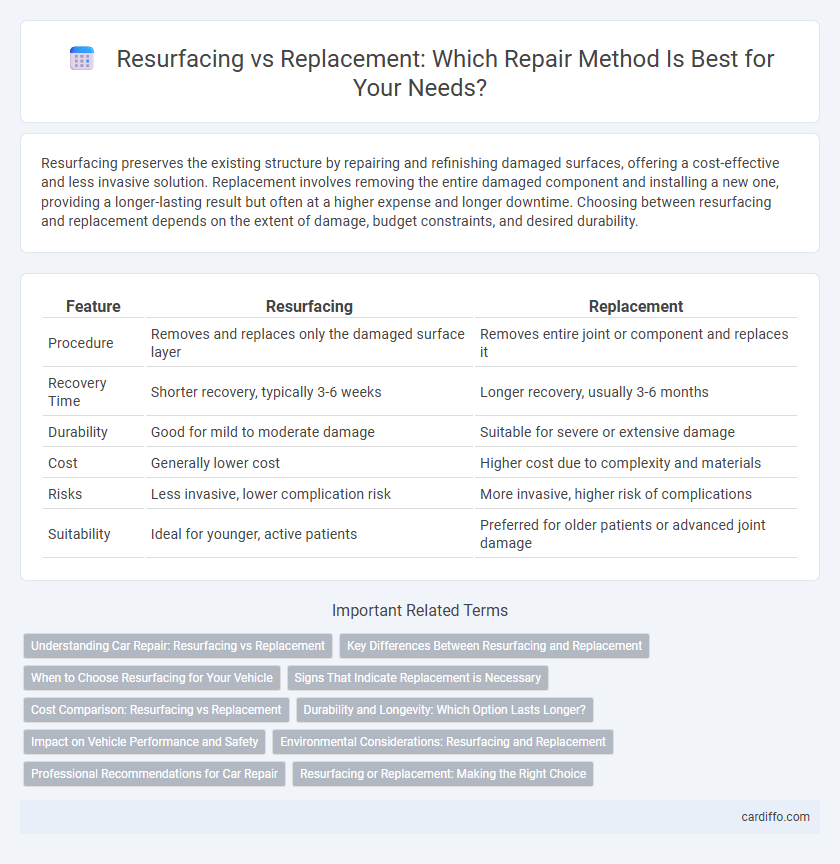Resurfacing preserves the existing structure by repairing and refinishing damaged surfaces, offering a cost-effective and less invasive solution. Replacement involves removing the entire damaged component and installing a new one, providing a longer-lasting result but often at a higher expense and longer downtime. Choosing between resurfacing and replacement depends on the extent of damage, budget constraints, and desired durability.
Table of Comparison
| Feature | Resurfacing | Replacement |
|---|---|---|
| Procedure | Removes and replaces only the damaged surface layer | Removes entire joint or component and replaces it |
| Recovery Time | Shorter recovery, typically 3-6 weeks | Longer recovery, usually 3-6 months |
| Durability | Good for mild to moderate damage | Suitable for severe or extensive damage |
| Cost | Generally lower cost | Higher cost due to complexity and materials |
| Risks | Less invasive, lower complication risk | More invasive, higher risk of complications |
| Suitability | Ideal for younger, active patients | Preferred for older patients or advanced joint damage |
Understanding Car Repair: Resurfacing vs Replacement
Resurfacing involves restoring a worn or damaged car part, such as brake rotors, by smoothing and refinishing its surface to extend its lifespan without the cost of a full replacement. Replacement entails removing the damaged component entirely and installing a new part, which is necessary when the damage is too severe for effective resurfacing. Choosing between resurfacing and replacement depends on factors like the extent of wear, cost considerations, safety requirements, and manufacturer recommendations.
Key Differences Between Resurfacing and Replacement
Resurfacing involves restoring the existing surface by removing damaged layers and applying a new finish, preserving much of the original structure, while replacement entails removing the entire component and installing a new one. Key differences include cost, with resurfacing typically being less expensive and quicker, and longevity, as replacement offers a longer-lasting solution by entirely renewing the part. Resurfacing suits minor damage or wear, whereas replacement is necessary for severe deterioration or structural compromise.
When to Choose Resurfacing for Your Vehicle
Resurfacing is ideal when your vehicle's brake rotors show minor wear, light scoring, or surface rust but remain thick enough to meet manufacturer specifications. It extends the lifespan of existing parts while maintaining braking performance and costs less than full replacement. Opt for resurfacing only if the rotors are free from deep grooves, cracks, or severe warping that compromise safety.
Signs That Indicate Replacement is Necessary
Visible cracks, severe deformation, and deep gouges on surfaces signal that resurfacing is insufficient, making replacement necessary to restore structural integrity. Persistent noise, excessive wear, and compromised functionality often indicate underlying damage beyond surface repair capabilities. When repair costs approach or exceed replacement expenses, opting for replacement ensures long-term performance and safety.
Cost Comparison: Resurfacing vs Replacement
Resurfacing typically costs 20% to 40% less than full replacement, making it a budget-friendly option for restoring functionality. While resurfacing reduces immediate expenses by preserving existing structures, replacement incurs higher initial costs but offers longer-term durability. Cost factors vary depending on material type, labor complexity, and extent of damage, with resurfacing favored for moderate wear and replacement suited for severe deterioration.
Durability and Longevity: Which Option Lasts Longer?
Resurfacing provides a cost-effective way to restore functionality by repairing the existing surface, often extending the lifespan by several years depending on the material and usage conditions. Replacement involves installing a new component, typically offering superior durability and longevity, often lasting decades with proper maintenance. Choosing between resurfacing and replacement depends on weighing immediate repair needs against long-term performance and cost-efficiency.
Impact on Vehicle Performance and Safety
Resurfacing brake rotors preserves more of the original material, maintaining optimal thickness and heat dissipation properties crucial for consistent braking performance and safety. Replacement rotors ensure improved reliability by eliminating potential structural weaknesses from wear or damage, directly enhancing vehicle stability and stopping power. Choosing between resurfacing and replacement impacts vehicle performance through the rotor's ability to resist warping and maintain even contact with brake pads, which is vital for safe and efficient braking.
Environmental Considerations: Resurfacing and Replacement
Resurfacing minimizes waste by preserving existing materials, significantly reducing landfill contributions and lowering the carbon footprint compared to full replacements. Replacement involves discarding old components, generating more waste and necessitating additional resource extraction, which impacts environmental sustainability. Choosing resurfacing supports eco-friendly practices by maximizing material reuse and reducing energy consumption in manufacturing new parts.
Professional Recommendations for Car Repair
Professional recommendations for car repair emphasize choosing resurfacing when brake rotors show minimal wear and remain within manufacturer specifications, as this option maintains structural integrity and saves costs. Replacement is preferred when rotors have deep grooves, warping, or have reached minimum thickness limits to ensure optimal braking performance and safety. Experts advise always following vehicle-specific guidelines and performing thorough inspections to determine the most reliable and cost-effective repair method.
Resurfacing or Replacement: Making the Right Choice
Resurfacing preserves more of the original material by smoothing and refinishing surfaces, making it a cost-effective option for extending the lifespan of components like engine parts or wooden floors. Replacement involves completely removing and installing new parts, offering a more permanent solution when damage is extensive or resurfacing cannot restore functionality. Evaluating factors such as cost, durability, and severity of wear is crucial in deciding whether resurfacing or replacement provides the best long-term value for repair projects.
Resurfacing vs Replacement Infographic

 cardiffo.com
cardiffo.com